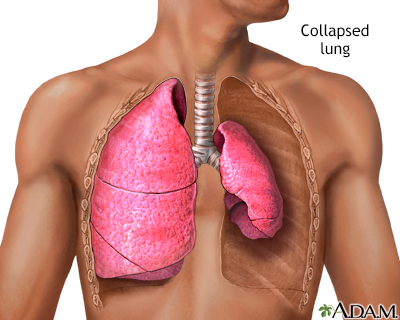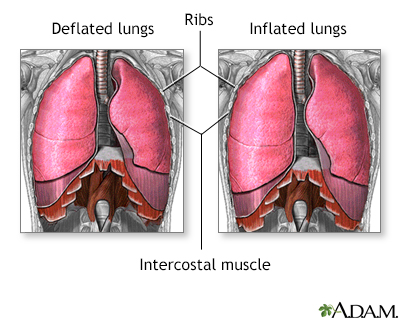Breathing difficulties - first aid
Difficulty breathing - first aid; Dyspnea - first aid; Shortness of breath - first aid
Most people take breathing for granted. People with certain illnesses may have breathing problems that they deal with on a regular basis.
This article discusses first aid for someone who is having unexpected or sudden breathing problems.
Breathing difficulties can range from:
- Being short of breath
- Being unable to take a deep breath and gasping for air
- Feeling like you are not getting enough air

A collapsed lung, or pneumothorax, occurs when all or part of a lung collapses or caves inward. This occurs when air gets in the area between the lung and chest wall. When this happens the lung cannot fill up with air, breathing becomes hard, and the body gets less oxygen. A collapsed lung can occur spontaneously in a healthy person or in someone who has lungs compromised by trauma, asthma, bronchitis, or emphysema.

The two lungs are the primary organs of the respiratory system. They sit to the left and right of the heart, within a space called the thoracic cavity. The cavity is protected by the rib cage. A sheet of muscle called the diaphragm serves Other parts of the respiratory system, such as the trachea, or windpipe, and bronchi, conduct air to the lungs. While the pleural membranes, and the pleural fluid, allow the lungs to move smoothly within the cavity. The process of breathing, or respiration, is divided into two distinct phases. The first phase is called inspiration, or inhaling. When the lungs inhale, the diaphragm contracts and pulls downward. At the same time, the muscles between the ribs contract and pull upward. This increases the size of the thoracic cavity and decreases the pressure inside. As a result, air rushes in and fills the lungs. The second phase is called expiration, or exhaling. When the lungs exhale, the diaphragm relaxes, and the volume of the thoracic cavity decreases, while the pressure within it increases. As a result, the lungs contract and air is forced out.

Breathing consists of two phases. The first phase is the inspiration phase. Inspiration allows air to flow into the lungs. The second phase is expiration. Expiration involves gases leaving the lungs. During inspiration, the diaphragm and intercostal muscles contract allowing air to enter the lungs. During expiration, the inspiration muscles relax forcing gases to flow out of the lungs.
Considerations
Breathing difficulty is often a medical emergency. An exception is feeling slightly winded from normal activity, such as exercise.
Causes
There are many different causes for breathing problems. Common causes include some health conditions and sudden medical emergencies.
Some health conditions that may cause breathing problems are:
- Anemia (low red blood cell count)
- Asthma
- Chronic obstructive pulmonary disease (COPD), that includes the conditions emphysema and chronic bronchitis
- Heart disease or heart failure
- Lung cancer, or cancer that has spread to the lungs
- Respiratory infections, including pneumonia, acute bronchitis, whooping cough, croup, and others
- Conditions which restrict the movement of the chest wall or diaphragm
- Certain neurologic conditions
Some medical emergencies that can cause breathing problems are:
- Blood clot in the lung
- Collapsed lung (pneumothorax)
- Heart attack
- High altitude pulmonary edema (HAPE)
- Injury to the neck, chest wall, or lungs
- Lung inflammation from chemical exposure
- Pericardial effusion (fluid surrounding the heart that can stop it from filling properly with blood)
- Pleural effusion (fluid surrounding the lungs that can compress them)
- Life-threatening allergic reaction
- Near drowning, which causes fluid buildup in the lungs
Symptoms
People having breathing difficulty will often look uncomfortable. They may be:
- Breathing rapidly
- Unable to breathe lying down and need to sit up to breathe
- Very anxious and agitated
- Sleepy or confused
They might have other symptoms, including:
- Dizziness or lightheadedness
- Pain
- Fever
- Cough
- Nausea
- Vomiting
- Bluish lips, fingers, and fingernails
- Chest moving in an unusual way
- Gurgling, wheezing, or making whistling sounds
- Muffled voice or difficulty speaking
- Coughing up blood
- Rapid or irregular heartbeat
- Sweating
If an allergy is causing the breathing problem, they might have a rash or swelling of the face, tongue, or throat.
If an injury is causing breathing difficulty, they might be bleeding or have a visible wound.
First Aid
If someone is having breathing difficulty, call 911 or your local emergency number right away, then:
- Check the person's airway, breathing, and pulse. If necessary, begin CPR.
- Loosen any tight clothing.
- Help the person use any prescribed medicine (such as an asthma inhaler, nitroglycerin, or home oxygen).
- Continue to monitor the person's breathing and pulse until medical help arrives. Do not assume that the person's condition is improving if you can no longer hear abnormal breath sounds, such as wheezing.
- If there are open wounds in the neck or chest, they must be closed immediately, especially if air bubbles appear in the wound. Bandage such wounds at once.
- A sucking chest wound allows air to enter the person's chest cavity with each breath. This can cause a collapsed lung. Bandage the wound with plastic wrap, a plastic bag, or gauze pads covered with petroleum jelly, sealing it on three sides, leaving one side unsealed. This creates a valve to prevent air from entering the chest through the wound, while allowing trapped air to escape from the chest through the unsealed side.
Do Not
Do not:
- Give the person food or drink.
- Move the person if there has been a head, neck, chest or airway injury, unless it is absolutely necessary. Protect and stabilize the neck if the person must be moved.
- Place a pillow under the person's head. This can close the airway.
- Wait to see if the person's condition improves before getting medical help. Get help immediately.
When to Contact a Medical Professional
Call 911 or your local emergency number if you or someone else has any of the symptoms of difficult breathing, in the Symptoms section above.
Also, contact your health care provider right away if you:
- Have a cold or other respiratory infection and are having difficulty breathing
- Have a cough that does not go away after 2 or 3 weeks
- Are coughing up blood
- Are losing weight without meaning to or having night sweats
- Cannot get to sleep or wake up at night because of breathing difficulty
- Notice it is hard to breathe when doing things that you normally do without breathing difficulty, for example, climbing stairs
Also contact your provider if your child has a cough and is making a barking sound or wheezing.
Prevention
Some things you can do to help prevent breathing problems:
- If you have a history of severe allergic reactions, carry an epinephrine pen and wear a medical alert tag. Your provider will teach you how to use the epinephrine pen.
- If you have asthma or allergies, eliminate household allergy triggers like dust mites and mold.
- Do not smoke, and keep away from secondhand smoke. Do not allow smoking in your home.
- If you have asthma, see the article on asthma to learn ways to manage it.
- Make sure your child gets the whooping cough (pertussis), influenza, COVID-19, and RSV (respiratory syncytial virus) vaccines if appropriate.
- Make sure your tetanus booster, influenza, pneumococcal and COVID-19 vaccines are up to date.
- When traveling by airplane, get up and walk around every few hours to avoid forming blood clots in your legs. Once formed, clots can break off and lodge in your lungs. While seated, do ankle circles and raise and lower your heels, toes, and knees to increase blood flow in your legs. If traveling by car, stop and get out and walk around regularly.
- If you are overweight, lose weight. You are more likely to feel winded if you are overweight. You are also at greater risk for heart disease and heart attack.
Wear a medical alert tag if you have a pre-existing breathing condition, such as asthma.
References
Goodloe JM, Soulek J. Foreign bodies. In: Walls RM, ed. Rosen's Emergency Medicine: Concepts and Clinical Practice. 10th ed. Philadelphia, PA: Elsevier; 2023:chap 51.
Hewett Brumberg EK, Douma MJ, Alibertis K, et al. American Heart Association and American Red Cross. 2024 American Heart Association and American Red Cross guidelines for first aid. Circulation. 2024;150(24):e519-e579. PMID: 39540278
Rose E. Pediatric upper airway obstruction and infections. In: Walls RM, ed. Rosen's Emergency Medicine: Concepts and Clinical Practice. 10th ed. Philadelphia, PA: Elsevier; 2023:chap 162.
Schwartzstein RM, Adams L. Dyspnea. In: Broaddus VC, Ernst JD, King TE, et al, eds. Murray and Nadel's Textbook of Respiratory Medicine. 7th ed. Philadelphia, PA: Elsevier; 2022:chap 36.
Version Info
Last reviewed on: 1/8/2025
Reviewed by: Jesse Borke, MD, CPE, FAAEM, FACEP, Attending Physician at Kaiser Permanente, Orange County, CA. Also reviewed by David C. Dugdale, MD, Medical Director, Brenda Conaway, Editorial Director, and the A.D.A.M. Editorial team.
